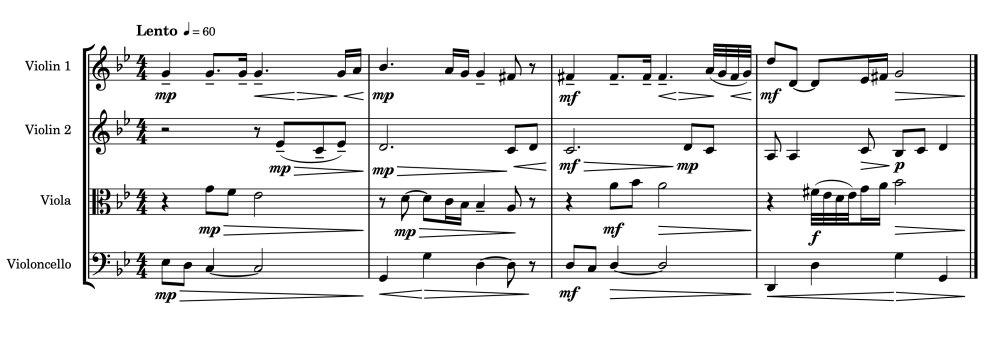Leaderboard
Popular Content
Showing content with the highest reputation on 06/24/2025 in all areas
-
Henry, I apologize for taking so long to reply to another great piece of yours. After many repeated listenings, this is clearly a programmatic piece in my opinion. There is anguish, anxiety and a false sense of repose. The juxtaposition between light and heavy themes, minor and major works effectively to convey the message of your piece. I have a few reservations about the random pauses that come after the blues. I feel they interrupt the flow at times, and as for the blues itself I think the f double sharp in the theme would sound better if it were changed to a g sharp. Those are just my thoughts tho; the climax and the aftermath of it is quite well done. I am glad you were able to find peace and transcendence in your sextet.2 points
-
Oh hey I like the contrabassoon idea, it's so rich in the lower register. Perhaps the easiest and right solution. Would it be so weird to have the piano with the orchestration? You mentioned harp, percussion, bells, etc., maybe the piano (or synth?) could be used as an accent/effect instrument in the ensemble. It could play the low notes of the final bass dyad in question, but just a random thought. Orchestration is really cool, and it helps I love Debussy haha. Nice work!2 points
-
This is the third and final movement of my Piano Sonata no.3 in C-sharp minor. It’s probably the most perplexing movement of music I have ever composed. For me it’s a struggle between Beethovenian heaviness (Es muss sein!) v.s. Unbearable lightness of blues (trying to imitate the style). Even though the first and second movement of the same Sonata has been commented as “random” before, I believe this one the most random of all haha. I once challenged myself whether to keep the eclecticism of the movement or not, but decided to leave it unchanged since all the styles were what I was thinking of and feeling at the moment. Here are the previous movements posted on YC before: 1st mov: 2nd mov: Piano Sonata no.3 in C-sharp minor 3rd mov.pdf The structure of the movement is a bit weird for me. It’s in Sonata form but the exposition and recapitulation never leave tonic key C-sharp minor at all, as the contrast of the 1st and 2nd subject is not achieved by key, but by style. In fact I only realized I was going for a Sonata form only when I almost finished the development section. Here is the structure of the movement: 0:00 Exposition, 1st Subject, 1st Theme: The falling fourth motive attacks immediately at the start of the movement in a passionate fashion, reminding himself of the pain he suffered after the more serene 2nd mov. It cools down in 0:31 and even keeps denying (or rather me denying my own sadness) by German sixth harmonic progressions, instead of normal dominant-tonic progression. 0:59 Exposition, 1st Subject, 2nd Theme: A deliberately repressed theme consisting of the inversion of a fourth, i.e. fifth, later gets more agitated with the Chopin Revolutionary Etude like L.H. accompaniment. It keeps on boiling until reaching the transition. I got crazy there thus I wanna try escaping… 2:28 Exposition, 2nd Subject: This section is made of 12 bar blues elements, thx to Arjuna’s @expert21 suggestion, although I already originally wanted some nihilistic jazz elements to contrast with the heavier 1st Subject. The pattern is repeated thrice, first just the “accompaniment”, then with the falling fourth motive theme added, and lastly an “electric-guitar-like” melody thx to of course my buddy Vince @Thatguy v2.0, as I won’t ever try to write something in jazz without his piano preludes. The locrian melody of course is a quotation from the 2nd mov opening! 3:46 Development, 1st Part: The opening falling fourth motive attacks again and modulates to keys I didn’t where it would go when composing lol, and finally reaches C# Locrian which confuses even me! It ends with a bridge of the locrian in L.H. quoting a little of the blues theme to the next part. 4:48 Development, 2nd Part: This part first develops the 2nd theme of 1st subject, then ends in confusion again. Suddenly a new theme emerges in the distant E-flat major and repeats again in relative major E major in a more passionate manner, until it boils down to a marvellously passionate retransition in 6:39 which I believe is the most beautiful section of the entire movement. It’s by composing this passage that I knew my creative power had finally come back. The passage ends in a desolation which leads back to the recap. 7:17 Recapitulation, 1st Subject, 1st part: A weird section. I finally could not refuse to admit my sadness by having a normal dominant-tonic progression, but still tried to escape by quoting the reminiscence of the blues themes like in a film montage jump cut in a Godard style (or, Stravinskian juxtaposition). 8:40 Recapitulation, 1st Subject, 2nd part: The 2nd theme of the expo 1st subject reappears in the L.H., and then a beautiful variation which I was probably laughing at myself for my weakness. The music goes on and gets more agitated until going to the 2nd subject. 9:32 Recapitulation, 2nd Subject: The previous “light-hearted” blues theme is transformed to an enraged Rachmanioffian roar. It subsequently cools down and tries to go for hope in the coda. 10:18 Coda, 1st Part: I tried to find peace by quoting the beautiful theme in the development plus 2nd mov’s 1st theme in counterpoint, repeat twice, 1st time in major and 2nd time pentatonic. The Locrian theme in the exposition is then transformed to a pentatonic plus the blue note of flattened sixth, signifying my attempt to find peace… 11:16 Coda, 2nd Part: However it’s futile. I realized that my sadness could not be “transcended”, at least not here, and finally realized my pain. The heavy falling fourth motive keeps attacking, and finally I was able to make a simple dominant-tonic chord progression to admit my pain, when the question is laid unanswered from the beginning of the entire sonata. The movement and the whole Sonata ended in utter desolation, as I had no energy anymore to fight as in the 1st mov and 2rd mov, nor create an imaginary utopia for myself as in 2nd mov and 3rd mov… The movement was primarily composed from Dec 2024 to Jan 2025, under a state of depression and confusion, due to what I had suffered in my full time job. I struggled a lot whether I should have a happy or sad ending for the whole sonata, but my mind gave me the answer. I could not pretend to be happy or hopeful at that time by forcing a meaningless Picardy-3rd at the end as in many of the Romantic Sonatas or pieces. I had to admit my sadness then. Paradoxically by doing that, I left all the negatives here so I had the 200% positiveness for my Sextet, which is my best piece and probably the most optimistic piece I ever composed. I tried my best at playing the movement already despite some slips haha. Hope you enjoy the movement and even go back to the 1st movement to listen to the whole Sonata! Thank you for listening,and possibly reading through this and commenting!!!!! Btw, here's Vince Preludes which inspire me: Prelude no.7: Prelude no.9: Prelude no.3: Henry1 point
-
Not sure if this is the right place for this post, but I came across something, quite simple but still fun. Was browsing youtube and stumbled upon a video. At the very beginning, the creator presented a 4 bar line of a Violin melody. (I've altered it a slight bit to make it a tiny bit more interesting. the original challenge melody reused the 1st measure, except with the same 4 32nd notes you see at the end of bar 3. I elected to simply change it to Gb, rather than staying on the G. I also included an ending 1 and a fine measure to sort of round it out a bit more. Here is the Challenge Melody): The instrumentation to be used for this challenge includes Vln. 1 & 2, Viola, and Cello. 4 Staves, with Vln. 1 already written for ya. Just curious to see what everyone else comes up with 🙂 Here is mine! I'm not a virtuoso or a master so mine will probably pale in comparison to some of yours. Lets see it! Harmony Challenge.mp31 point
-
Hi to everyone. This week I've been working on an exercise to orchestrate Debussy's Prelude No.6 from Book 1. I came up with two versions, one with a very restricted instrumentation, and the other with a larger ensemble. Interested to know which you think works best? The final bass dyad was very problematic, due to its extreme low pitch. It sounded too intrusive and twangy in the harp, and seemed off-pitch in the double-bass, with a horrible grating timbre. Eventually I decided to remove the lowest note altogether in the version with restricted instrumentation, and have the upper note pizz. instead of arco.1 point
-
Thank you for listening and giving feedback. I do agree with the meandering nature of the piece. The more I listen to it, the more I wonder where it’s going. Changing up the tempo could possible help with that as well. Also, it does change keys. It goes E minor, D major, G minor, D minor, G Major, then back to E minor.1 point
-
1 point
-
An Incredible orchestral landscape. I think you captured the loneliness of the piece quite well; the pedal effects are achieved naturally by the sustaining quality of the winds and strings. Just keep in mind, those triple and quadruple pianos may be hard to project, if you get a real ensemble to play your piece. It’s interesting to hear how differently you’ve approached this prelude as compared to another recent orchestration: Of course, I also hear similarities but I do really prefer your choice of instruments. There seems to be more drama and depth of feeling.1 point
-
Thanks Mark. I could perhaps use more contrabassoon for bass resonance. Not sure double-bass would work. Its timbre is a bit too harsh, and doesn't really suit the material IMHO. I did have thoughts about adding some percussion. Perhaps a mark tree, sleigh bells or triangle to sprinkle some Christmassy magic? Maybe that would sound too cheesy though?1 point
-
Alex - overall both are very good orchestrations of the piano work. After listening to the piano work, I found, I missed the resonance of the lower notes vibrating (pedal). I'm not sure how to reproduce this quality in the lower winds and/or lower strings etc. Mark1 point
-
1 point











